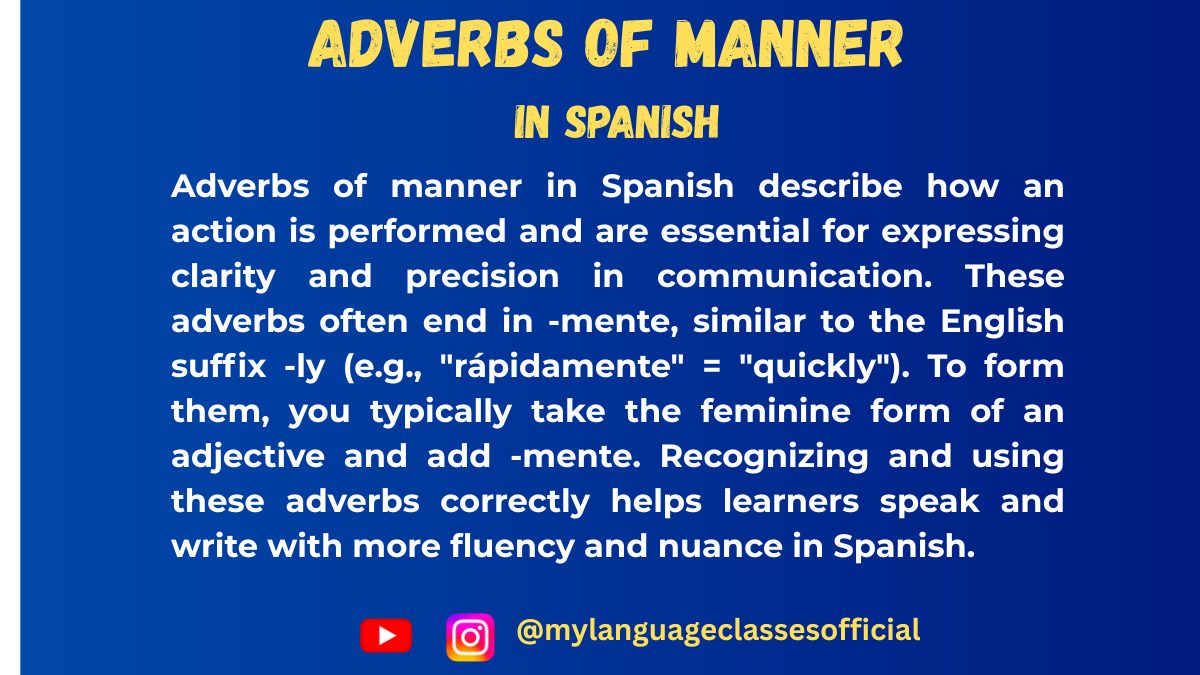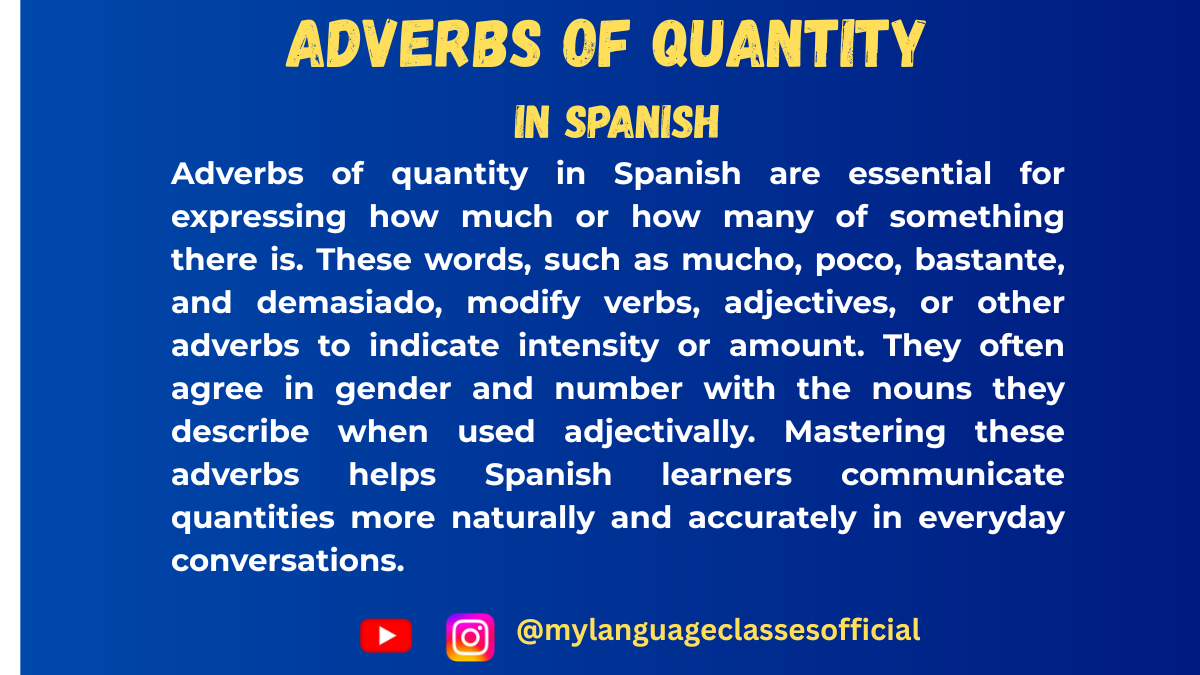Your cart is currently empty!
Tag: examples of Spanish adverbs
-

Adverbs of Manner in Spanish: Learn How to Use “-mente” Like a Native
When learning Spanish, one of the keys to sounding natural and fluent is mastering adverbs of manner—those handy little words that describe how an action is performed. Just like in English (e.g., quickly, gently, carefully), Spanish has its own set of adverbs that can bring clarity, precision, and flair to your sentences.
In this post, we’ll break down how to form and use adverbs of manner in Spanish, highlight some tricky exceptions, and help you avoid common learner mistakes. Whether you’re just starting out or looking to polish your Spanish expression, this guide will give you the tools to speak and write more naturally.
Let’s dive in and explore the how behind every action—en español.

🧩 What Are Adverbs of Manner in Spanish?
If you’re learning Spanish grammar, one key topic to understand is adverbs of manner. These are words that tell us how an action is performed, and they’re essential for speaking and writing Spanish more fluently.
✅ Definition:
Adverbs of manner in Spanish (adverbios de modo) describe how something happens—in other words, they explain the manner in which an action takes place.
For example:
- Ella canta dulcemente.
(She sings sweetly.) - Él escribe cuidadosamente.
(He writes carefully.)
In both sentences, the adverb gives us more detail about how the action is being done. This is a big part of building more natural, expressive sentences in Spanish.
🎯 Why Are Adverbs of Manner Important?
Understanding how to use Spanish adverbs of manner helps learners create more specific and natural sentences. It’s one of the key grammar skills needed to speak Spanish fluently and with confidence.
Whether you’re a beginner trying to learn basic Spanish grammar or an intermediate learner looking to improve your writing, this topic is essential. You’ll often come across these adverbs in conversations, books, and media—so the more familiar you are with them, the better!
📚 Difference Between Adverbs of Manner and Other Spanish Adverbs
Spanish adverbs come in many forms—not just adverbs of manner. To really learn Spanish adverbs effectively, it helps to compare the different types.
Type of Adverb Question Answered Example English Translation Adverb of Manner ¿Cómo? Habla suavemente She speaks softly Adverb of Time ¿Cuándo? Llegó temprano He arrived early Adverb of Place ¿Dónde? Está aquí She is here Adverb of Quantity ¿Cuánto? Estudia mucho He studies a lot Adverb of Cause ¿Por qué? No vino porque llovía He didn’t come because it was raining So, while adverbs of manner in Spanish grammar describe the way an action is done, other adverbs focus on time, place, quantity, or reason.
How to Form Adverbs of Manner in Spanish
Once you understand what adverbs of manner in Spanish are, the next step is learning how to form them. Luckily, Spanish grammar rules for this are quite regular — especially compared to English!
✅ Basic Rule: Add “-mente” to the Feminine Form of the Adjective
To form most Spanish adverbs of manner, simply take the feminine singular form of an adjective and add -mente, which is the Spanish equivalent of the English “-ly” (as in slowly, quickly, happily).
📌 Examples:
- rápido → rápidamente (quick → quickly)
- fácil → fácilmente (easy → easily)
- claro → claramente (clear → clearly)
- correcto → correctamente (correct → correctly)
So if you’re wondering how to use adverbs of manner in Spanish, this is your go-to rule!
⚠️ Spelling & Accent Notes
When the original adjective has an accent, it usually keeps it after adding -mente.
- fácil → fácilmente
- cómodo → cómodamente
This follows standard Spanish spelling and pronunciation rules, so the stress stays natural.
❗ Irregular & Common Exceptions
Not all adverbs follow the -mente rule. Some common Spanish adverbs of manner are formed irregularly or don’t use -mente at all. These are important to memorize:
📌 Examples:
- bien (well)
- mal (badly)
- despacio (slowly)
- así (like this / in this way)
These often appear in everyday conversations and are frequently used by native Spanish speakers.
⚠️ Adjectives Used as Adverbs
Some adjectives can function as adverbs without changing form. These are often used after verbs.
Examples:
- Corre rápido. (Run fast.)
- Habla claro. (Speak clearly.)
- Camina despacio. (Walk slowly.)
💡 Quick Tip for Learners
If two adverbs with -mente appear together, Spanish often only adds -mente to the last one.
🗣️ Example:
Habló clara y cuidadosamente.
(She spoke clearly and carefully.)This keeps the sentence natural and fluid — a great trick to sound more fluent!
List of Common Adverbs of Manner and Example
Spanish English Meaning Example Sentence Bien Well Ella canta bien. (She sings well.) Mal Badly, poorly Hiciste el trabajo mal. (You did the job badly.) Rápido / Rápidamente Fast, quickly Terminaron la tarea rápido. (They finished the homework fast.) Despacio Slowly Habla despacio, por favor. (Speak slowly, please.) Suavemente Gently Tocó la puerta suavemente. (He knocked on the door gently.) Claramente Clearly Explicó el problema claramente. (She explained the problem clearly.) Cuidadosamente Carefully Maneja cuidadosamente. (Drive carefully.) Fácilmente Easily Puedo resolver esto fácilmente. (I can solve this easily.) Fuertemente Strongly El viento soplaba fuertemente. (The wind was blowing strongly.) Alegremente Happily Bailaron alegremente en la fiesta. (They danced happily at the party.)
Things to Keep in Mind When Using Adverbs of Manner
1. Placement of Adverbs
- In Spanish, adverbs of manner generally go after the verb they modify:
- Ella canta bien. (She sings well.)
- If modifying an adjective or another adverb, they come before it:
- Está muy feliz. (She is very happy.)
2. Agreement of Adverbs
- Unlike adjectives, adverbs do not change for gender or number:
- Ellos trabajan rápidamente. (They work quickly.)
- Ella habla rápidamente. (She speaks quickly.)
3. Difference Between Adjective and Adverb Usage
- Incorrect: Ella es bien en matemáticas. ❌
- Correct: Ella es buena en matemáticas. ✅
- “Bien” is an adverb, while “buena” is an adjective.
- Incorrect: Él corre rápidamente en la carrera. ❌
- Correct: Él corre rápido en la carrera. ✅
- Some adjectives can function as adverbs without “-mente.”
Expressions with Adverbs of Manner in Daily Life
Here are some commonly used expressions with adverbs of manner:
Expression Meaning “Más vale tarde que nunca.” Better late than never. “Habla claro.” Speak clearly. “Hazlo bien o no lo hagas.” Do it well or don’t do it. “Trabaja duro.” Work hard. “Pídelo amablemente.” Ask for it politely. “Siempre actúa con prudencia.” Always act wisely. “No conduzcas tan rápido.” Don’t drive so fast.
⚠️ 3. Common Mistakes to Avoid
Even advanced learners of Spanish make errors with adverbs of manner. Here are some common mistakes to watch out for:
❌ 1. Using the adjective instead of the adverb
- Incorrect: Él habla claro.
- Correct: Él habla claramente.
(Adverbs describe how someone does something — not adjectives.)
❌ 2. Forgetting the feminine form before adding -mente
- Incorrect: rápido → rápidomente
- Correct: rápido → rápidamente
Always use the feminine singular form of the adjective.
❌ 3. Translating directly from English
English: She runs fast.
Learners often try: Ella corre rápida.
Correct: Ella corre rápidamente / Ella corre rápido (when used informally)
🔍 4. Tricky Points and Special Cases
Some cases don’t follow the usual -mente pattern. These are exceptions and commonly used alternatives:
✅ Informal and Irregular Adverbs:
- bien (well)
- mal (badly)
- despacio (slowly)
- así (like this/that)
✅ Double Adverbs:
When using two -mente adverbs, only the last one keeps the suffix:
- Ella habló clara y cuidadosamente.
✅ Sentence Placement:
Adverbs of manner usually follow the verb:
- Canta suavemente.
But they can also go at the end: - Habló rápidamente.
📝 Example Sentences with Translation
- Ella habla claramente. — She speaks clearly.
- Juan corre rápidamente. — Juan runs quickly.
- Ellos trabajan cuidadosamente. — They work carefully.
- Ella escribe lentamente. — She writes slowly.
- Él responde educadamente. — He responds politely.
- María canta dulcemente. — María sings sweetly.
- El bebé duerme tranquilamente. — The baby sleeps peacefully.
- El estudiante respondió correctamente. — The student answered correctly.
- Cocinamos fácilmente con esta receta. — We cook easily with this recipe.
- Hablan amablemente con los clientes. — They speak kindly with the customers.
- El perro camina silenciosamente. — The dog walks silently.
- Marta resolvió el problema inteligentemente. — Marta solved the problem cleverly.
- Él contestó mal. — He answered badly.
- Bailaron alegremente. — They danced happily.
- Reaccionó violentamente. — He reacted violently.
- Cocinó rápido. — He cooked fast.
- Lo hizo bien. — He did it well.
- Llegaron puntualmente. — They arrived punctually.
- El niño contestó tímidamente. — The boy answered shyly.
- Nos miraron extrañamente. — They looked at us strangely.
🧠 Exercise: Fill in the Blanks
Fill in each blank with the correct Spanish adverb of manner:
- Ella canta ___ (sweet).
- Él corre ___ (fast).
- María escribe ___ (slow).
- Respondió ___ (politely).
- Trabajan ___ (careful).
- Marta resolvió el examen ___ (intelligent).
- Juan llegó ___ (punctual).
- Ellos hablaron ___ (friendly).
- Lo hizo ___ (well).
- El perro entró ___ (silent).
- El niño respondió ___ (shy).
- Ella cocinó ___ (easy).
- Gritó ___ (angry).
- Me miraron ___ (strange).
- Él actuó ___ (honest).
- Completó la tarea ___ (correct).
- El bebé duerme ___ (peaceful).
- Manejó ___ (dangerous).
- Él bailó ___ (happy).
- Lo resolvió ___ (simple).
✅ Answers
- Ella canta dulcemente.
- Él corre rápidamente.
- María escribe lentamente.
- Respondió educadamente.
- Trabajan cuidadosamente.
- Marta resolvió el examen inteligentemente.
- Juan llegó puntualmente.
- Ellos hablaron amablemente.
- Lo hizo bien.
- El perro entró silenciosamente.
- El niño respondió tímidamente.
- Ella cocinó fácilmente.
- Gritó violentamente.
- Me miraron extrañamente.
- Él actuó honestamente.
- Completó la tarea correctamente.
- El bebé duerme tranquilamente.
- Manejó peligrosamente.
- Él bailó alegremente.
- Lo resolvió simplemente.
📌 Summary: Key Points About Adverbs of Manner in Spanish
- Adverbs of manner (adverbios de modo) describe how an action is done.
- Most are formed by adding -mente to the feminine singular form of an adjective.
- Irregular and informal adverbs include: bien, mal, despacio, así.
- Adverbs typically come after the verb but can be placed at the end of the sentence.
- Avoid using adjectives instead of adverbs.
- Double adverbs only need -mente on the second one.
- Practice with real sentences and fill-in-the-blank activities helps internalize usage.
🏁 Conclusion: Mastering Spanish Adverbs of Manner
Learning how to use adverbs of manner in Spanish is a major step toward building richer, more expressive sentences. Whether you’re speaking or writing, these words help you describe actions with clarity and confidence. From understanding basic grammar rules to practicing real-life examples, you’ve now got a strong foundation for mastering adverbios de modo.
👉 Ready to go further?
Explore our section on Spanish grammar👉And if you found this guide helpful, don’t forget to subscribe to My language Classes, leave a comment, or share it with fellow learners!
👉Subscribe to My YouTube channel
👉Join our WhatsApp group for real time updates and discussion.
👉Follow on Instagarm
Check out our related post on Types of Adverbs in Spanish 👇👇
Adverbs of Time in Spanish: A Complete Guide
- Ella canta dulcemente.

